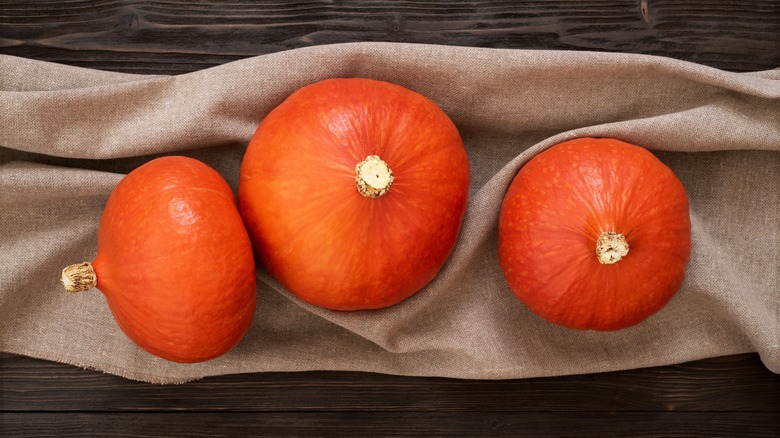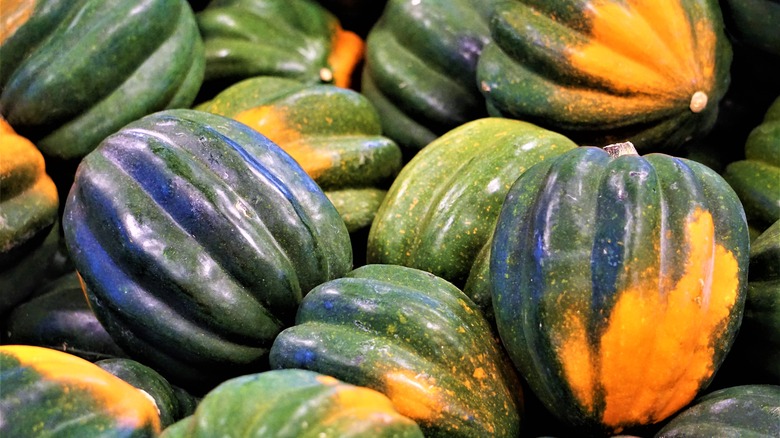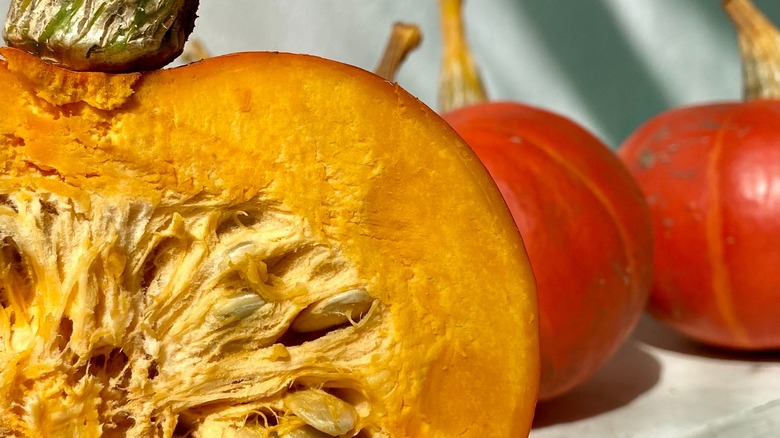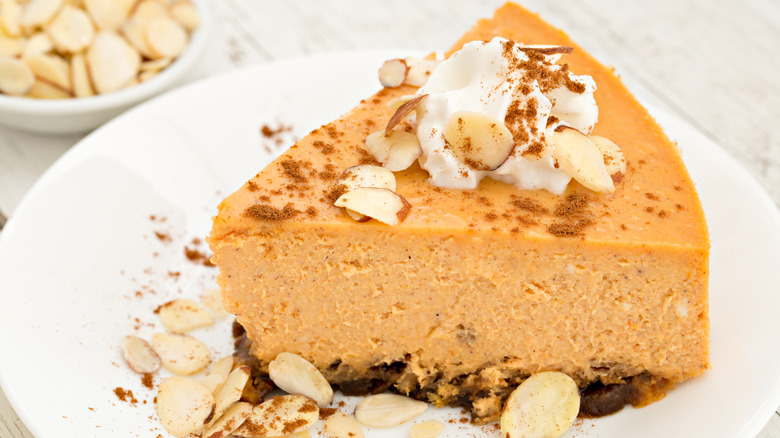Japan's Red Kuri Squash Adds Nutty Flavor To Winter Meals
If we challenged you to pick a winter vegetable that's just as iconic as asparagus in spring or ripe tomatoes in mid-summer, what would it be? For a lot of people, the obvious choice would be winter squash. It's one of those sturdy, long-storing vegetables our ancestors relied on in the days before refrigeration, and it's still a cold-season staple even now.
Winter squashes, in general, are tasty, comforting, and — let's face it — pretty much interchangeable. So why is Japan's Red Kuri squash (Cucurbita maxima) suddenly the buzzy, trendy choice popping up in restaurants and specialty retailers across the U.S.? There are a lot of possible answers to that question. One is the novelty factor because offering a new spin on an old favorite is never a bad option. Mostly, though, it just boils down to the fact that the Red Kuri is a really easy squash to like.
What is Red Kuri squash?
All squashes are part of the larger Cucurbitae family, which spans everything from the smallest pickling cucumber to Smart car-sized competition pumpkins. Most pumpkins and squashes belong to just four species within that family: Cucurbita maxima, Cucurbita pepo, Cucurbita moschata, and Cucurbita mixta (also called C. argyrosperma).
The Red Kuri squash is in the Cucurbita maxima species, like the buttercup and big Hubbard squashes you already know. In fact, the Red Kuri is probably descended from the Hubbard.
It was developed and first grown on the island of Hokkaido in Japan, and it's hugely popular in that country. You may also see it sold under various other names, including Hokkaido squash, climbing onion squash, potimarron, or the self-explanatory "baby red Hubbard." No matter what it's called or where it's grown, one thing you can be sure of is that the Red Kuri is a popular local favorite.
How is Red Kuri different from other winter squashes?
Winter squashes come in all sizes, from tiny striped Sweet Dumplings to massive banana squashes, and in shapes that mostly can be described as either long or round. The Red Kuri is one of the round squashes, tapering to a narrow point at the stem end (hence the "climbing onion" name).
It's a mid-sized squash, typically checking in at just 3 to 7 pounds. That's a good, versatile size that will work for most households: Pick a small one if it's just the two of you or a larger one for a bigger family. Its skin is a bright and cheerful red-orange; hence the "Red" part of its name, and the deeply colored flesh inside is also darker than you'll find in most winter squashes.
Red Kuri is a meaty squash with thick flesh surrounding the pocket of edible seeds. This sets it apart from some other common choices with thinner walls or butternut squash with its thick neck but awkwardly thin seed cavity. A Kuri will cook evenly rather than forcing you to compensate for thick and thin areas.
Is Red Kuri much like acorn squash?
If you're looking for a familiar frame of reference, acorn squashes provide a good comparison. They're a common squash that most of us are familiar with, and like the Red Kuri, they're modestly sized. While you can use each squash in similar preparations, there are some definite differences between them.
First, the Red Kuri is larger than acorn squash. Acorn squash reaches weights from 1 to 3 pounds, while Kuris start at 3 pounds and go up from there. Acorn squashes are usually green but also come in white, golden, and striped versions. Even the golden acorns can't match the vivid hue of a Red Kuri, and the smaller squash's signature acorn shape and sharply ridged sides make it pretty hard to mistake in any case.
Culinarily, the acorn squash isn't as thick and meaty as a Red Kuri and isn't as fully flavored. Because it's so small, it's a two-person squash at most, while a Kuri can feed an entire family, depending on its size. More importantly, the ridges on an acorn squash make it time-consuming to peel despite its softer skin. If you like winter squash and often buy acorns because of their conveniently small size, trying Red Kuri as an alternative may be well worth your while.
How does Red Kuri taste?
You might call the Red Kuri a "Goldilocks" squash in size because it's not too big and not too small, and it's equally agreeable in flavor. It's rich and nutty-tasting, and it's sweet but not as cloyingly sweet as some other varieties of squash can be.
The most common comparison is to sweet and starchy chestnuts. In fact, Kuri is the Japanese word for chestnut, and similarly, in French, the Red Kuri is called potimarron, a mashup of the words for pumpkin and chestnut. If you haven't tasted chestnuts or have only had them in their candied form, the best summary is sweet but not too sweet.
Its texture is just as easy to like. Some squashes, like the popular butternut, are relatively moist when cooked. Others are dry and fluffy like a russet potato, and in fact, there's even a variety called the "mashed potato" squash. A Red Kuri squash leans slightly to the dry side, cooking up a smooth and creamy texture that purees beautifully. If you interpreted that as "dry, but not too dry," then congratulations! You've spotted the recurring theme. It really is a very easy squash to love.
How nutritious is Red Kuri squash?
A quick look at the USDA's nutrition data for winter squash will tell you that they're a pretty healthy addition to your diet. It's harder to track down nutrition data for the Red Kuri specifically, but according to the popular health site and app MyFitnessPal it's high in vitamins A and C and packs useful quantities of iron, calcium, and fiber as well.
The Kuri's unusually deep color may also intrigue you because of the popular wisdom that dark-colored vegetables tend to be more nutritious than their paler equivalents. There's good evidence that this is true in a broad sense — in fact, encouraging people to eat more dark green, red, and orange vegetables is an explicit nutritional goal of the U.S. government — but it's hard to find studies comparing lighter and darker-fleshed cultivars of the same plant.
It doesn't matter because the health benefits of dark yellow and orange vegetables are well established, and like other winter squashes, the Red Kuri ticks many boxes. It's fat-free, low in calories, loaded with vitamins and a few key minerals, and chips in with some fiber as well. That makes it a good fit for just about any diet or healthy eating plan, with the exception of the various low-carb strategies. Realistically, if you're low-carb, you already know that squash is something you'll enjoy sparingly, if at all.
Red Kuri is close to Kabocha
At this point, you may be wondering whether Red Kuri is similar to the Kabocha squash, another Japanese favorite that has enjoyed a rise in popularity here in North America.
The two squashes are similar in a lot of ways, and both are Cucurbita maxima species. Kabocha can grow to about 8 pounds, but typically, the ones you'll see at the market are 2 to 3 pounds in weight. The weight range for Red Kuri is about the same, so with either squash, you can choose a larger or smaller one as needed. Kabocha will most often be green, though there is a "red" version as well that looks a lot like a Red Kuri. The tell-tale difference is that the Kuri tapers at the stem end, while a Kabocha is flat at the top.
Kabocha cooks up to a relatively dry and fluffy texture, rather like the buttercup squash, which it closely resembles. The Kuri will be slightly moister and creamier when cooked. As for flavor, the two are very much alike and are loved for their sweet, nutty flavor.
How to buy and store Red Kuri squash
Winter squashes are a late-season crop, which means you'll typically start seeing them in mid-autumn, and then they'll slowly disappear from produce sections over the winter as supplies run low. Talk to the produce manager at your local supermarket to see if it's available through their system, or check at the farmer's market to see if your favorite grower has it. If not, perhaps they'd be willing to grow it next year.
Visually, look for the Red Kuri's signature pointy-topped onion or teardrop shape and bright red-orange hue. Choose a squash with unblemished skin that shows no soft spots or mold and is heavy for its size, which means it's fresh and hasn't lost moisture to transpiration. Taken together, those three signs will tell you if it's an older specimen or hasn't been stored properly.
Once you've chosen your Kuri and taken it home, find a cool, dark, well-ventilated spot to store it. It doesn't need refrigeration and can be kept for months under good conditions. Once you cut into it, you'll need to wrap and refrigerate the leftover pieces, if you have any, and then use them within a week or two. According to StillTasty, cooked squash should be eaten within 3 to 5 days, like most other foods.
How to prepare Red Kuri squash
Red Kuri squash is a versatile vegetable, and you can cook it in any number of ways. We'll circle back to that, but first, let's look at the prep you'll need to do before cooking it.
The Red Kuri's just-right size makes it a good candidate for baking whole, which is certainly the easy option. In that case, you'll just cut the top open and scoop it out. You can also halve it or cut the halves into half-moon slices at the cook's whim. As with other hard-skinned winter squashes, this requires a strong arm and a sharp knife. For food safety reasons, you should always scrub the skin of your squash under cold running water to remove soil and bacteria before cutting into it.
You can also dice Red Kuri for roasting, stews, or curries, though because of the relatively hard skin, you'll need a sharp paring knife or a good peeler. Oddly, once it's cooked, the skin is tender enough to eat, unlike those of many other winter squashes.
How to cook Red Kuri squash
Now that you've prepared the squash, you have any number of options for how you cook it. Simply baking it in your oven is an appealing choice because you won't need to do any further prep beyond scooping out the seeds — which can also be roasted and eaten — and halving it if you choose to. You can also stuff the whole squash with your filling of choice. For vegans, this can turn the simple squash into a very effective special occasion meal for holidays or other get-togethers.
Slices or cubes of diced Red Kuri are excellent when roasted and can be glazed to double down on sweetness or taken in a savory direction with herbs and spices. Diced Kuri is also a fine ingredient to use in soups, stews, and curries (and who could resist making a Kuri curry?).
One of the Red Kuri's distinctive traits is how smoothly textured it is once it's pureed. That makes it an excellent choice for rich autumnal soups and especially baked goods because ordinarily, a homemade puree won't give you the kind of smooth texture you'd get from a canned product.
How to preserve Red Kuri squash
Falling in love with a relatively hard-to-find vegetable like the Red Kuri can be frustrating simply because it's so seasonal and such a niche product. Even in California, where it's relatively widely grown, most of the domestic product is exported back to Japan to meet demand there.
The short answer to this problem is simply to grab yourself a Kuri whenever you see it, even if you don't have immediate plans to cook one. They keep well for months as-is, but you can assure yourself of a year-round supply by preserving them for later use. The simplest option is to bake your squash, puree it, pack the puree into zipper-lock freezer bags, and then press the bags flat to squeeze out any extra air. You can pull out a whole bag for meals or baking as needed or break off a single-serving portion and put the rest back.
If you're an avid canner, you can pressure-can diced Kuri squash using the instructions given at the National Center for Home Food Preservation. Once processed, the jars will be shelf-stable for a few years and ready to eat at the drop of a hat. You can also thin-slice the squash and dehydrate it, pickle it in pieces or shreds, or even candy it as a sweet treat.
Growing your own Red Kuri squash
If you have trouble finding Red Kuri squash in your area, or if the supply is unreliable, you can address that issue by growing your own. Squashes are notorious "space invaders" in the garden when you allow them to sprawl naturally, but you can save space by trellising them so they'll grow vertically. You can even grow a plant or two in containers on your balcony or deck if you don't have an outdoor garden.
Although winter squashes, in general, are a late-season crop, Red Kuri is actually a relatively early variety at 100 days or less. Long-season gardeners can direct-seed them once the soil temperature reaches 65 degrees Fahrenheit; short-season gardeners should start them indoors 3 to 4 weeks ahead of time and then harden them off and plant them out once the soil has warmed up.
Start checking your squashes about three months later to evaluate whether they're ready. Harvest when their skins are hard to the touch, leaving 2 to 4 inches of stem attached to the squash. Kuris will last longest if you leave them to cure in a warm, well-ventilated, sunny spot for 10 days after harvest. For more detailed instructions suitable to your growing area, reach out to your local extension service or master gardening program.
Use it in soups, stews and curries
We've already mentioned that Red Kuri is an ideal choice for soups because it purees to a beautifully silky-smooth texture. Ginger and maple are two flavors you'll often find in squash soups, and they'll both play nicely with a Red Kuri, but you'll find a world of other options beyond those two established favorites.
Consider this Southeast Asian butternut squash bisque, with its signature regional flavors of coconut milk, lemongrass, and Sriracha. It's hearty and warming, just the thing to take the chill out of your bones on a raw winter's day.
You probably won't find many curry recipes that specify a Red Kuri squash, but this one for Kabocha squash curry is a slam-dunk because Kabocha and Red Kuri share a similar flavor profile. That specific recipe doesn't adhere to a given regional style, but any Indian, Thai, or Japanese curry that calls for winter squash should work beautifully with Kuri.
Its mild, rich sweetness provides a good foil for assertive curry seasonings, no matter whether you're using a store-bought powder, a Thai-style paste, or rolling your own from the contents of your spice rack.
Red Kuri is great in snacks and treats
Once you start experimenting with Red Kuri, there's no reason to draw the line at savory recipes. There's no botanical difference between pumpkin and winter squash (those names are random and traditional, not scientific), and canned "pumpkin" often contains squash, so it's not that odd. Also, because Kuri purees so well, it'll give a smoother result in a scratch-baked dish than most other varieties.
Sweet, lunchbox-friendly treats are always useful to have on hand, and this pumpkin streusel muffin would be a welcome addition to any kid's (or adult's) lunch. Just swap out the pumpkin puree for your own Kuri puree, and you're good to go. On the other hand, if you like your treats a bit less sweet and a bit more virtuous, these 5-ingredient pumpkin cookies might fit the bill. Better yet, they're simple enough for kids — or the baking-challenged — to make on their own.
Arguably, the ultimate seasonal pumpkin or Red Kuri treat is a donut. Yes, that's right, forget about apple cider: How about a fresh-made donut filled with lush pumpkin custard? That's what you'll get with these pumpkin pie donuts, created by Tasting Table recipe developer Jessica Morone. You may never again settle for plain old pumpkin pie.













